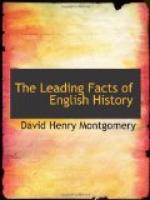III. Military Affairs
519. Armor and Arms.
Armor still continued to be worn in some degree during this period, but it consisted chiefly of the helmet with breastplates and backplates. Firearms of various kinds were in general use; also hand grenades, or small bombs, and the bayonet. The chief wars of the period were the Civil War, the wars with the Dutch, William’s war with France, which extended to America, and the War of the Spanish Succession.
IV. Literature, Learning, and Art
520. Great Writers.
The most eminent prose writers of this period were Sir Walter Raleigh, Lord Bacon, Sir Isaac Newton, John Bunyan, Bishop Hooker, Jeremy Taylor, John Locke, Hobbes, Dean Swift, Defoe, and Addison; the chief poets, Shakespeare and Jonson (mentioned under the preceding period), Milton, Dryden, Pope, Butler, and Beaumont and Fletcher, with a class of writers known as the “Comic Dramatists of the Restoration,” whose works, though not lacking in genius, exhibit many of the worst features of the licentious age in which they were produced. Three other great writers were born in the latter part of this period,— Fielding, the novelist, Hume, the historian, and Butler,[1] the ablest thinker of his time in the English Church,—but their productions belong to the time of the Georges.
[1] Bishop Butler, author of “The Analogy of Religion” (1736), a work which gained for him the title of “The Bacon of Theology.”
521. Progress in Science and Invention.
Sir Isaac Newton revolutionized natural philosophy by his discovery and demonstration of the law of gravitation, and Dr. William Harvey accomplished as great a change in physiological science by his discovery of the circulation of the blood. The most remarkable invention of the age was a rude steam engine, patented in 1698 by Captain Savery, and so far improved by Thomas Newcomen in 1712 that it was used for pumping water in coal mines for many years. Both were destined to be superseded by James Watt’s engine, which belongs to a later period (1765).
522. Architecture.
The Gothic style of the preceding periods was followed by the Italian, or classical, represented in the works of Inigo Jones and Sir Christopher Wren. It was a revival, in modified form, of the ancient Greek and Roman architecture. St. Paul’s Cathedral, the grandest church ever built in England for Protestant worship, is the best example of this style. Many beautiful manor houses were built in the early part of this period, which, like the churches of the time, were often ornamented with the exquisite wood carving of Grinling Gibbons. There were no great artists in England in this age, though Charles I employed Rubens and other foreign painters to decorate the palace of Whitehall and Windsor Castle.
523. Education.
The higher education of the period was confined almost wholly to the study of Latin and Greek. The discipline of all schools was extremely harsh. Nearly every lesson was emphasized by a liberal application of the rod, and the highest recommendation a teacher could have was that he was known as “a learned and lashing master.”




